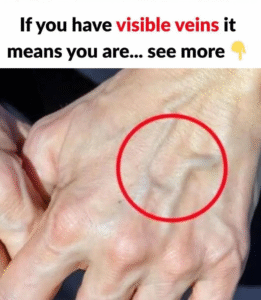When to Be Concerned About Blood Vessels That Suddenly Become Visible
Suddenly visible blood vessels under the skin can be alarming, especially when they appear without any clear reason. While in many cases prominent veins are harmless and simply a cosmetic issue, there are times when they may indicate an underlying medical concern that should not be ignored.
One of the most common and harmless reasons for suddenly visible veins is increased physical activity. When you exercise—especially with strength training or cardiovascular workouts—your blood flow increases, and your muscles swell, pushing veins closer to the surface of your skin. This is particularly noticeable in people with low body fat or lean body types. Similarly, weight loss can reduce the layer of fat under your skin, making veins more noticeable. Heat exposure can also temporarily enlarge veins as your body works to cool itself down, causing them to rise to the surface.
Age is another benign factor. As we grow older, the skin becomes thinner and loses elasticity and collagen, allowing veins to appear more prominently, especially in the hands and legs. Pregnancy can also cause visible veins due to hormonal changes and increased blood volume, which puts added pressure on blood vessels.
However, there are instances where suddenly visible blood vessels may be a sign of something more serious. If veins appear suddenly and without a clear cause, and especially if they are accompanied by pain, swelling, redness, or warmth, this could be a symptom of vascular inflammation or a blood clot, such as deep vein thrombosis (DVT). DVT typically affects the legs and is considered a medical emergency because clots can break loose and travel to the lungs, causing a pulmonary embolism.
Varicose veins, which are enlarged, twisted veins often appearing in the legs, may also become suddenly prominent. While they are not always dangerous, they can lead to discomfort, aching, and in severe cases, skin changes or ulcers.
More rarely, the sudden visibility of veins in the chest or abdomen—especially if accompanied by abdominal swelling, jaundice, or fatigue—can be a sign of liver disease, such as cirrhosis, where increased pressure in the portal vein system causes collateral veins to appear on the surface of the abdomen, a condition known as caput medusae.
Additionally, if veins are suddenly visible in tandem with easy bruising, fatigue, or frequent nosebleeds, this might suggest a blood clotting disorder or a condition affecting the vascular system or bone marrow, such as leukemia.
In summary, while visible veins can be completely normal in certain contexts, they may also point to underlying health concerns in others. It is important to consider the location of the veins, any accompanying symptoms, and whether there are changes in your overall health. If you are unsure or if the appearance of veins is accompanied by other unusual signs, it’s best to consult a healthcare provider for a thorough evaluation.


